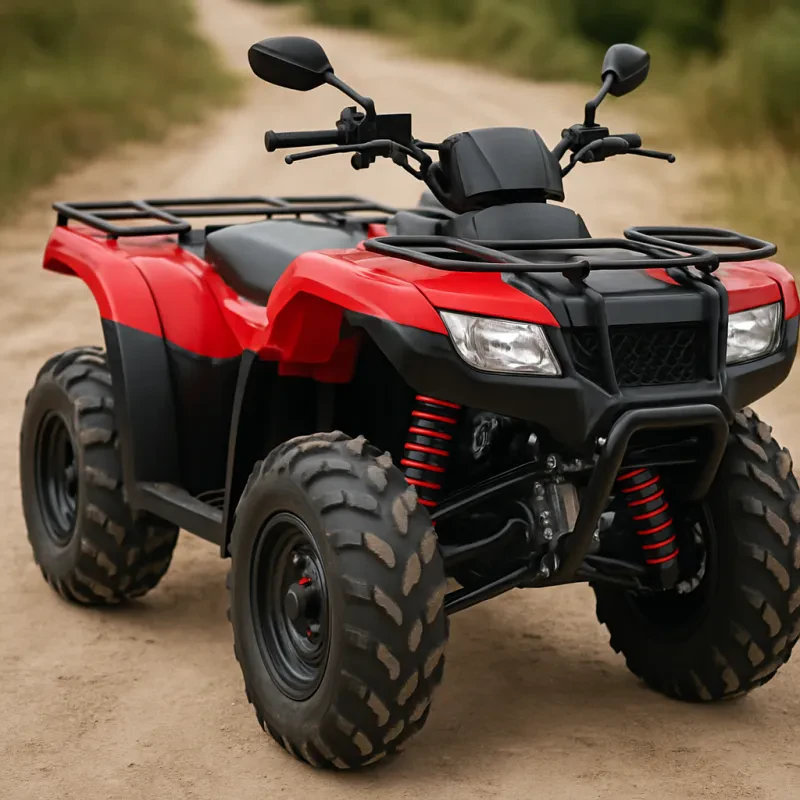When it comes to off-road adventures, understanding the benefits and features of 4-wheel ATVs can help riders make informed decisions. 4-wheel ATVs are designed for agility and speed, making them ideal for navigating tight trails and uneven terrains. Their lightweight design allows for easier maneuverability and can be particularly beneficial when sharp turns and quick acceleration are needed. This flexibility is often a deciding factor when comparing options in the larger debate of 4-wheel vs 6-wheel ATV.
One of the standout features of 4-wheel ATVs is their suspension system. Many models come equipped with advanced suspension technology, which provides better shock absorption and smoother rides over rough surfaces. This makes them a favorite for recreational riders who prioritize comfort during longer excursions. Additionally, the power-to-weight ratio in 4-wheel ATVs is typically advantageous, delivering impressive performance without the bulk of heavier models.
Another important aspect to consider is the range of applications for 4-wheel ATVs. They are versatile vehicles that can be used for various activities, from racing and trail riding to work-related tasks like hauling tools or supplies across rugged terrains. This adaptability makes them a popular choice for both recreational users and professionals who require a reliable all-terrain vehicle. When weighing the options in the 4-wheel vs 6-wheel ATV discussion, it’s clear that 4-wheel ATVs offer unique benefits that cater to many needs.
Lastly, maintenance and customization also play a role in the appeal of 4-wheel ATVs. Many riders appreciate the ease of finding parts and accessories that allow for personal modifications. The market is filled with aftermarket options that can enhance performance, aesthetics, and safety. This customizability further enhances the appeal of 4-wheel ATVs in the ongoing conversation about which type is the best choice for various riding styles and conditions in the 4-wheel vs 6-wheel ATV debate.
Exploring the Advantages of 6-Wheel ATVs
When it comes to the debate of 4-Wheel vs 6-Wheel ATV, one of the standout features of 6-Wheel ATVs is their superior stability. With an extra pair of wheels, these vehicles are designed to distribute weight more evenly, which provides enhanced traction on uneven terrains. This is particularly beneficial for those who venture into rugged landscapes or muddy trails, making 6-Wheel ATVs ideal for off-road adventures.
Another significant advantage of 6-Wheel ATVs is their impressive load-carrying capacity. The additional wheels not only increase stability but also allow these vehicles to handle heavier loads with ease. This makes them perfect for farmers, hunters, or outdoor enthusiasts who require extra hauling power for equipment, supplies, or even game. While considering 4-Wheel vs 6-Wheel ATV options, those needing more functionality and utility will find 6-Wheel ATVs to be a practical choice.
Moreover, 6-Wheel ATVs often come equipped with more robust suspension systems. This feature ensures a smoother ride over bumps and dips, providing greater comfort for both the driver and any passengers. The enhanced suspension means less jarring and a more enjoyable experience during longer rides, which is particularly advantageous when traversing tough terrain. In the 4-Wheel vs 6-Wheel ATV comparison, the comfort and capability of the 6-Wheel model cannot be overlooked.
Finally, 6-Wheel ATVs are generally better suited for diverse environmental conditions. Whether you are dealing with snow, mud, or sand, the increased number of wheels helps to maintain better grip and control. This versatility makes 6-Wheel ATVs a solid choice for those who want to explore a range of different landscapes without worrying about getting stuck. In the ongoing discussion of 4-Wheel vs 6-Wheel ATV, the adaptability of the 6-Wheel model stands out as a significant advantage.
Key Differences Between 4-Wheel and 6-Wheel
When it comes to choosing the right ATV, understanding the key differences between a 4-Wheel and a 6-Wheel ATV can significantly influence your riding experience. One major difference lies in their design and intended use. A 4-Wheel ATV is typically lighter and more agile, making it ideal for quick maneuvers on trails. In contrast, a 6-Wheel ATV offers greater stability and is often designed for heavier loads, making it perfect for tasks like hauling equipment or traversing rough terrain.
Another important consideration is the terrain capability. A 4-Wheel ATV excels on smooth trails and is well-suited for high-speed rides. This type of ATV is the go-to choice for recreational riders who enjoy speed and agility. On the other hand, the 6-Wheel ATV features better traction and weight distribution, making it an excellent choice for off-roading in muddy or rocky conditions. For those who frequently navigate challenging landscapes, the added wheels provide an advantage that can be crucial for maintaining momentum.
Handling and comfort are also impacted by the wheel count. The 4-Wheel ATV generally provides a sportier feel, which many riders find enjoyable. However, the 6-Wheel ATV tends to have a more comfortable ride, thanks to its larger footprint. This can be especially beneficial for long rides or for those who might be carrying passengers or heavy loads. Therefore, depending on what you prioritize—agility or comfort—the choice between a 4-Wheel vs 6-Wheel ATV becomes clearer.
Finally, consider the maintenance and customization options. While both types of ATVs require regular upkeep, the 4-Wheel ATV often has a wider range of aftermarket accessories available for enhancing performance and aesthetics. Meanwhile, the 6-Wheel ATV may come with more specialized equipment options tailored to utility and work-related tasks. Understanding how you plan to use your ATV will help guide your choice in this critical aspect.
Making the Right Choice for Your Needs
When it comes to choosing between a 4-Wheel vs 6-Wheel ATV, it's essential to consider your specific needs and preferences. Each type of ATV offers unique benefits that cater to different riding styles and terrains. For instance, 4-Wheel ATVs are typically lighter and more agile, making them great for maneuvering through tight trails and quick turns. If you enjoy racing or recreational riding in less demanding environments, a 4-Wheel ATV might be your best bet.
On the other hand, if you plan to tackle tougher terrains, such as mud or rocky paths, a 6-Wheel ATV could be the more suitable option. These ATVs usually provide better stability and traction, thanks to their additional wheels. They are designed to carry heavier loads and navigate challenging landscapes with ease. Therefore, if your adventures include hauling equipment or traversing off-road trails, the 6-Wheel vs 4-Wheel ATV debate leans toward the 6-Wheel option.
Another factor to consider is how many passengers you plan to accommodate. Many 4-Wheel ATVs are meant for solo riders, while 6-Wheel models often come with extra seating space. If family outings or group rides are on your agenda, a 6-Wheel ATV can offer that additional capacity without compromising on comfort.
Ultimately, the decision between a 4-Wheel vs 6-Wheel ATV boils down to personal preference and the types of adventures you envision. Evaluate your riding environment, load requirements, and comfort needs to pick the ATV that aligns best with your lifestyle. Whether you choose a nimble 4-Wheel ATV or a robust 6-Wheel ATV, ensure it suits your intended use for an enjoyable ride.

